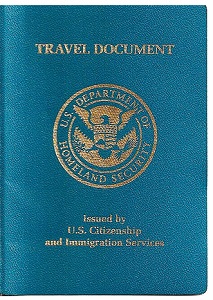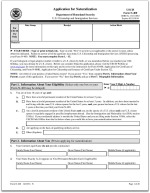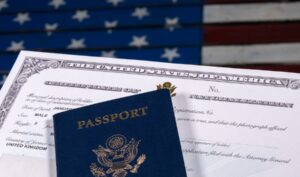
When applying for U.S. citizenship via naturalization, English and civics tests get much of the attention. But permanent residents often do not understand how travel abroad can affect their eligibility for naturalization.
Two related but separate requirements, continuous residence and physical presence, must be satisfied for one to be eligible to file Form N-400, Application for Naturalization. Excessive travel abroad can adversely affect eligibility. Excessive travel can include one long trip or the accumulation of several trips over the period that precedes your admission as a U.S. citizen.
Continuous Residence
Continuous residence means that the applicant has maintained residence within the United States for a specified period of time. An applicant must have continuous residence in the United States as a lawful permanent resident for at least 5 years immediately preceding the date of filing N-400, Application for Naturalization. The continuous residence requirement is adjusted to 3 years for an applicant filing as a permanent resident married to a U.S. citizen. For certain military applicants, immigration law completely waives the requirement.
The purpose of the continuous residence requirement is to establish the applicant’s genuine intent to integrate with American society and not just take advantage of the benefits of U.S. citizenship. USCIS wants to know that the applicant truly wants to become a citizen. The continuous residence requirement helps the applicant demonstrate that he or she has begun to integrate with American community and intends to stay in the U.S. long term. So how long can one be absent from the United States?
Disrupting the Continuous Residence Requirement
In general, the following guidelines apply for permanent residents who are traveling abroad:
- A trip abroad that is less than 6 months will not disrupt continuous residence.
- A trip abroad of 6-12 months will likely disrupt continuous residence.
- A trip abroad 12 months or longer will disrupt continuous residence.
USCIS officers are also well aware of the games some people play. They will examine all of the trips taken during the 5 years that precede the filing of the application. USCIS will notice if the applicant has taken multiple trips which appear calculated to take less than six months. (For example, the applicant travels abroad for 5 months and 15 days, returns to the U.S. for 10 ten days, then leaves again for another 5 months.) The USCIS officer may consider the two separate trips as one long trip of more than 10 months.
RECOMMENDED: Continuous Residence and Physical Presence Requirements
Physical Presence
Physical presence means that the applicant has been physically present within the United States for a specified period of time. A permanent resident must have 30 months of physical presence in the United States over the 5 years immediately preceding the date of filing N-400, Application for Naturalization. The physical presence requirement is reduced to 18 months for permanent residents married to a U.S. citizen (over a 3-year period). And again the requirement may be waived for certain applicants who have served the U.S. government.
Unlike continuous residence, physical presence is a cumulative requirement. When calculating physical presence, the permanent resident must combine each day that he or she was inside the United States. If a permanent resident spends more time abroad than in the United States, it raises concerns that the U.S. may not be his or her true home.
RECOMMENDED: Continuous Residence and Physical Presence Requirements
Calculate Continuous Residence & Physical Presence
An N-400 applicant can determine time as a permanent resident by reviewing his or her green card. You can find the date that permanent residence status began on the green card next to “Resident Since.” Calculate this manually or start CitizenPath’s N-400 Eligibility Quiz.

Note: If you came to the United States as a refugee, your permanent residence date will be backdated to the day you arrived in the U.S. If you were initially in asylum status, it will be backdated one year.
USCIS will count the day that an applicant departs from the United States and the day he or she returns as days of physical presence within the United States for naturalization purposes.
Travel as a Permanent Resident
Immigration law allows lawful permanent residents to travel abroad freely and re-enter the United States with a valid green card. But extensive travel may affect permanent resident status as well as eligibility for U.S. citizenship.
As a rule, permanent residents should not travel outside the United States for periods of six months or more. When a permanent resident spends significant time outside the United States, it may give rise to the notion that he/she has abandoned his/her permanent resident status.
Travel Under Six Months
A permanent resident may generally leave the United States and re-enter less than six months later without any issues. To re-enter he or she must provide valid proof of permanent resident status. Most people may use a valid, unexpired permanent resident card (green card) for re-entry. File Form I-90, Application to Replace Permanent Resident Card, to renew a green card that will expire in six months or less.
Travel Longer Than Six Months But Less Than a Year
If an applicant is absent from the United States for a period of more than six months, but less than one year, there will be a presumption that he or she has disrupted continuous resident. This includes any absence that takes place prior to filing the naturalization application or between filing and the applicant’s admission to citizenship. The applicant will have to demonstrate proof of residence. In other words, the person will have to show that he/she did not abandon residence in the U.S. and that the U.S. is the primary place of residence. Although many applicants have done this on their own, we recommend that you seek the support and advice of an immigration attorney that can help you document your case. Examples of evidence may include, but are not limited to documents that show the applicant:
- Did not terminate his or her employment in the United States or obtain employment while abroad.
- Had immediate family who remained in the United States.
- Retained full access to his or her United States residence.
Travel Longer Than One Year
An absence from the United States for a period of one year or more during the period for which continuous residence is required will break the continuous residence requirement. Again, the applicable period includes time prior to and after filing the naturalization application.
What’s more, if a permanent resident stays outside the U.S. for one year or longer without securing a reentry permit, the government may try to revoke the person’s permanent residence.

A naturalization applicant who is required to establish continuous residence for at least five years and whose application for naturalization is denied due to an absence of one year or longer, may apply for naturalization four years and one day after returning to the United States to resume permanent residence. (An applicant who is subject to the three-year continuous residence requirement may apply two years and one day after returning to the United States to resume permanent residence.)
Most attorneys prefer that their clients do not travel abroad once the applicant has filed Form N-400. However, it is possible. If you would like to travel outside the United States during the naturalization process or if you plan to travel abroad for a period of six months are more, please speak to an experienced immigration attorney that can explain the ramifications.
Travel Abroad After Filing Form N-400
Many naturalization applicants want to know if it’s permissible to travel abroad after filing Form N-400, Application for Naturalization. The simple answer is “yes,” but there are several considerations. First, you continue to be a permanent resident and have the right to travel outside the United States, even after filing Form N-400. But your absence from the U.S. still has the potential to interfere with your eligibility and the application process.
Continuous Residence
The continuous residence requirement is still in effect. You must have resided continuously in the United States after your permanent residence admission for at least five years prior to filing the naturalization application and up to the time of naturalization. (For an applicant applying on the basis of three years of permanent residence while married to a U.S. citizen, the same is true. The continuous residence requirement counts up to the time of naturalization.) Therefore, the trip should be short and certainly less than six months in duration.
USCIS Appointments
Another consideration when traveling abroad after filing Form N-400 is the obligation to attend mandatory USCIS appointments. For most candidates, there will be three key appointments: the biometric appointment, the naturalization interview, and the oath ceremony. While you may typically reschedule these appointments, make every attempt to attend the appointment as scheduled. Missing an appointment and failure to address the absence can lead to a denial of your application. We provide an approximate N-400 time line that outlines the steps after filing Form N-400. However, USCIS schedules these appointments and may deviate from the estimated time line.
Exceptions to Continuous Residence and Physical Presence Requirements
There are special provisions in the law that exempt members of the U.S. armed forces, certain business travelers, religious workers, government employees, and researchers for a U.S. research agency, from the continuous residence requirement. This allows certain individuals to maintain eligibility for U.S. citizenship despite travel abroad for long periods.
Such applicants must file a Form N-470, Application to Preserve Residence for Naturalization Purposes. You must meet the following criteria to qualify for Form N-470:
- The applicant must have been physically present in the United States as a lawful permanent resident for an uninterrupted period of at least one year prior to working abroad.
- The application may be filed either before or after the applicant’s employment begins, but before the applicant has been abroad for a continuous period of one year.
In addition, the applicant must have been employed:
- With or under contract with the U.S. government or an American institution of research recognized as such by the Attorney General;
- By an American firm or corporation engaged in the development of U.S. foreign trade and commerce, or a subsidiary thereof if more than 50 percent of its stock is owned by an American firm or corporation; or
- By a public international organization of which the United States is a member by a treaty or statute and by which the applicant was not employed until after becoming a lawful permanent resident.
If you believe that you may meet these criteria, contact an experienced immigration attorney to discuss your options.
About CitizenPath

CitizenPath provides simple, affordable, step-by-step guidance through USCIS immigration applications. Individuals, attorneys and non-profits use the service on desktop or mobile device to prepare immigration forms accurately, avoiding costly delays. CitizenPath allows users to try the service for free and provides a 100% money-back guarantee that USCIS will approve the application or petition. We provide support for Green Card Renewal (Form I-90), the Citizenship Application (Form N-400), and several other immigration forms.
Note to Reader: This post was originally published on March 10, 2015, and has been modified with improvements.
Want more immigration tips and how-to information for your family?
Sign up for CitizenPath’s FREE immigration newsletter and
SAVE 10%
on our immigration services




